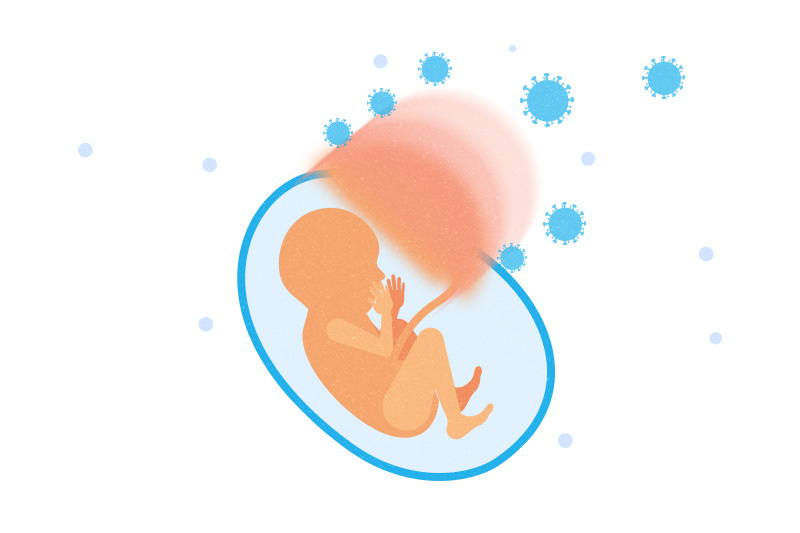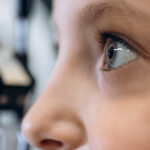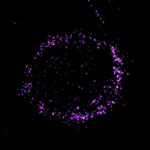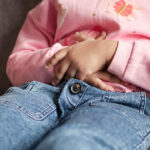How does the placenta protect unborn babies from COVID-19?

Evidence has shown that pregnancy is a risk factor for severe illness in women with COVID-19. A recent CDC study reviewed case reports of approximately 400,000 women aged 15 to 44 with symptomatic COVID-19. Those who were pregnant had a roughly tripled likelihood of ICU admission and invasive ventilation and 70 percent higher mortality.
Yet their newborns are mostly doing well. Reports indicate that babies born to COVID-19-infected mothers are infected only about 5 percent of the time. Moreover, most of those who test positive have mild or asymptomatic infections, rarely needing mechanical ventilation.
Elizabeth Taglauer, MD, PhD, a placental immunologist in the Division of Newborn Medicine at Boston Children’s Hospital, wants to know why these babies are so resilient. Could the placenta have shielded them from COVID-19?
“The lack of maternal-fetal transmission is one positive aspect of COVID,” she says. “I study the immune system at the maternal-fetal interface, and this seemed like an area where I could contribute to research efforts.”
Examining the placenta’s response to COVID-19
The placenta is a complex, highly specialized, still little-understood organ. It helps prevent the mother’s immune system from rejecting her own fetus, while also preventing most bacteria and some viruses from passing from mother to baby.
To explore the placental response to SARS-CoV-2, the virus that causes COVID-19, Taglauer teamed up with Elisha Wachman, MD, a former colleague from her residency. Wachman is now at Boston Medical Center (BMC), which has been hit hard by COVID-19. Together they began following COVID-19-positive pregnant mothers and studying a variety of maternal and fetal samples, including placentas discarded after delivery.
Since April 2020, Taglauer and Wachman’s team at BMC have built a biorepository of almost 80 placentas from COVID-19-positive mothers. Samples encompass the decidua (the layer closest to the mother), the placental villi (the branching projections through which mother and baby exchange nutrients), the chorionic plate (on the fetal side), and the membranes around the baby.
Their early findings, from COVID-19-positive women who gave birth in April and May 2020, indicate that the virus can penetrate the placenta, but only partially. Surprisingly, even when babies were uninfected, the SARS-CoV-2 spike protein was detectable in the placental villi, and specifically in the outermost syncytiotrophoblast (sTB) layer. That layer directly contacts the mother’s blood and is the first barrier the virus must cross to get from mother to baby.
The researchers also found ACE2, the primary receptor for SARS-CoV-2, in the outer sTB layer of the villi in placentas from infected mothers, but at lower levels than in placentas from uninfected mothers. Taglauer speculates that it’s infected, the placenta down-regulates ACE2 as a protective measure, a possibility she plans to investigate in further studies. Another protein the virus uses to enter cells, TMPRSS2, was also present in placental tissues from infected and uninfected mothers, but at overall lower levels than ACE2. This suggests that SARS-CoV-2 may use other receptors to penetrate the placenta, another question for further exploration.
Analyzing the placenta cell by cell
Taglauer and Wachman are now collaborating with Jeffrey Moffitt, PhD, in the Program in Cellular and Molecular Medicine at Boston Children’s, to delve more deeply into placentas from mothers with and without COVID-19. Moffitt’s laboratory uses a technology called MERFISH that directly images RNA, capturing the full complement of gene “readouts” in individual cells. The team will analyze every cell within the placental tissues and profile the genes important to COVID-19.
A COVID-19 placenta repository
Taglauer and Wachman are offering their curated biorepository of placental tissue as a resource for others and inviting further collaborations. For more information, email elizabeth.taglauer@childrens.harvard.edu.
“Understanding how the placenta protects babies from COVID-19 could help us understand more about how COVID-19 invades other organs, like the lungs, so we can develop treatments to counter the virus,” says Taglauer. “The anatomy of the placenta is very similar to that of the developing lungs and intestines at certain stages. And unlike lung or intestinal tissue from COVID-19 patients, we can get our hands on this tissue right away.”
“This information can tell you what each cell is doing, and what it’s doing in relation to the cells around it,” says Taglauer. “We’re investigating the molecular response to COVID-19 in placental tissue from top to bottom, from the interface with the mother to the interface with the baby. This will be critical in understanding how the virus enters the placenta but is ultimately blocked from getting to the fetus, likely somewhere between the placental cells and the fetal circulation.”
Learn more about the Division of Newborn Medicine.
Related Posts :
-

New research sheds light on the genetic roots of amblyopia
For decades, amblyopia has been considered a disorder primarily caused by abnormal visual experiences early in life. But new research ...
-

Thanks to Carter and his family, people are talking about spastic paraplegia
Nine-year-old Carter may be the most devoted — and popular — sports fan in his Connecticut town. “He loves all sports,” ...
-

A new druggable cancer target: RNA-binding proteins on the cell surface
In 2021, research led by Ryan Flynn, MD, PhD, and his mentor, Nobel laureate Carolyn Bertozzi, PhD, opened a new chapter ...
-

Genetic causes of congenital diarrhea and enteropathy come into focus
Congenital diarrheas and enteropathies are rare and devastating for infants and children. Treatments have consisted mainly of fluid and nutritional ...





